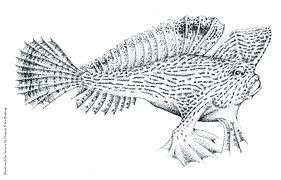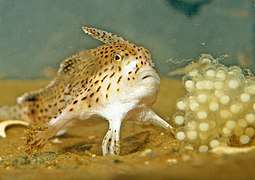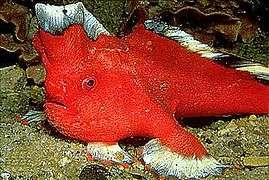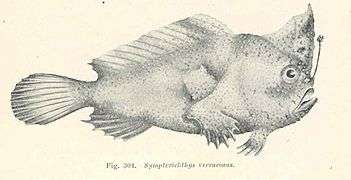Handfish
Handfish are any anglerfish within the family Brachionichthyidae, a group which comprises five genera and 14 extant species.[2] These benthic marine fish are unusual in the way they propel themselves by walking on the sea floor rather than swimming.
| Handfish | |
|---|---|
 | |
| Brachionichthys hirsutus | |
| Scientific classification | |
| Kingdom: | Animalia |
| Phylum: | Chordata |
| Class: | Actinopterygii |
| Order: | Lophiiformes |
| Suborder: | Antennarioidei |
| Family: | Brachionichthyidae T. N. Gill, 1878 |
| Genera | |
|
Brachionichthys | |
Distribution
Handfish are found today in the coastal waters of southern Australia and Tasmania. This is the most species-rich of the few marine fish families endemic to the Australian region.
Anatomy
Handfish grow up to 15 cm (5.9 in) long, and have skin covered with denticles (tooth-like scales), giving them the alternate name warty anglers. They are slow-moving fish that prefer to 'walk' rather than swim, using their modified pectoral fins to move about on the sea floor. These highly modified fins have the appearance of hands, hence their scientific name, from Latin bracchium meaning "arm" and Greek ichthys meaning "fish".
Like other anglerfish, they possess an illicium, a modified dorsal fin ray above the mouth, but it is short and does not appear to be used as a fishing lure. The second dorsal spine is joined to the third by a flap of skin, making a crest.[3]
 The critically endangered spotted handfish, Brachionichthys hirsutus
The critically endangered spotted handfish, Brachionichthys hirsutus Drawing of the spotted handfish
Drawing of the spotted handfish Female spotted handfish with her eggs
Female spotted handfish with her eggs
 Thymichthys verrucosus
Thymichthys verrucosus
Fossil record
The prehistoric species, Histionotophorus bassani, from the Lutetian of Monte Bolca, is now considered to be a handfish, sometimes even being included in the genus Brachionichthys.
Extinction
In March 2020 the smooth handfish, Sympterichthys unipennis, was declared extinct in the IUCN Red List.[4][5] Once common enough to be one of the first fish to be described by European explorers of Australia, but not seen for well over a century, this is the first modern-day marine fish to be officially declared extinct.[5]
In 1996 the spotted handfish, Brachionichthys hirsutus, was the first marine fish to be listed as critically endangered in the IUCN Red List.[5][6]
References
- Sepkoski, Jack (2002). "A compendium of fossil marine animal genera". Bulletins of American Paleontology. 364: 560. Archived from the original on April 30, 2008.
- Last, P.R.; Gledhill, D.C. (2009). "A revision of the Australian handfishes (Lophiiformes: Brachionichthyidae), with descriptions of three new genera and nine new species" (PDF). Zootaxa. 2252: 1–77.
- Pietsch, Theodore W. (2005). "Brachionichthyidae". Tree of Life web project. Retrieved 4 April 2006.
- International), Graham Edgar (Conservation; Last (CSIRO), Peter; Tasmania), Rick Stuart-Smith (University of (2018-05-01). "IUCN Red List of Threatened Species: Sympterichthys unipennis". IUCN Red List of Threatened Species. Retrieved 2020-06-18.
- "Smooth Handfish Extinction Marks a Sad Milestone". Scientific American. Retrieved 2020-06-18.
- International), Graham Edgar (Conservation; Last (CSIRO), Peter; Tasmania), Rick Stuart-Smith (University of (2018-04-30). "IUCN Red List of Threatened Species: Brachionichthys hirsutus". IUCN Red List of Threatened Species. Retrieved 2020-06-18.
External links
| Wikimedia Commons has media related to Brachionichthyidae. |
| Wikispecies has information related to Brachionichthyidae |